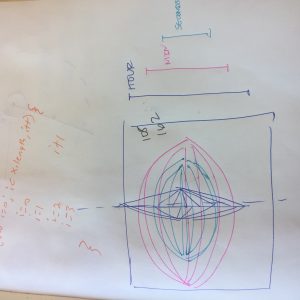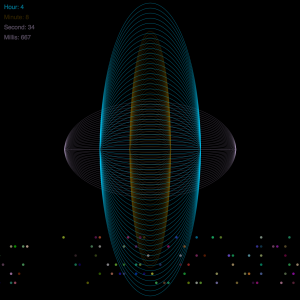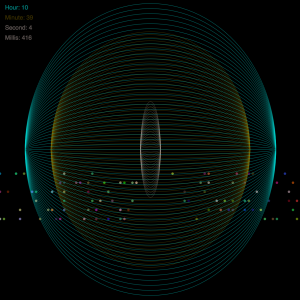//Grace Cha
//Section C
//heajinc@andrew.cmu.edu
// 6. Project 06 – Abstract Clock
//This is inspired by cellular mitosis and splitting of chromosomes.
//The way you tell time is by measuring the center to each side of the width
//HOUR: Tallest circular object (up/down way)
//Minute: medium tallest object
//Second: shortest object
var prevSec;
var millisRolloverTime;
//time variables
var H;
var M;
var S;
//These lines are for the random changing dots
var x = [];
var y = [];
var dx = [];
var dy = [];
var col = [];
var dots = 100;
function setup() {
createCanvas(600, 600);
millisRolloverTime = 0;
for (var i = 0; i < 200; i ++){
H = hour();
M = minute();
S = second();
x[i] = random(width) * cos(radians(20));
y[i] = random(height) * sin(radians(20));
dx[i] = H;//use seconds just as a velocity movement
dy[i] = M;//this does not actually move per second.
col[i] = color(random(255), random(255), random(255),150);
}
}
function draw() {
background(0);
M = minute();
S = second();
if (prevSec != S) {
millisRolloverTime = millis();
}
prevSec = S;
var mils = floor(millis() - millisRolloverTime);
//this makes time go by 12 hours
if (H > 12){
H = H - 12;
}
//this make 12 o clock "12" rather than "0"
if (H == 0){
H = 12;
}
push();
var r = 40 + 25 * sin(millis() / 1000.0 );
var g = 230 + 25 * sin(millis() / 1000.0 + HALF_PI);
var b = 230 + 25 * sin(millis() / 1000.0 - HALF_PI);
fill(0,g,b,140);
text("Hour: " + H, 10, 22);
pop();
push();
var r = 100 + 25 * sin(millis() / 1000.0 );
var g = 100 + 25 * sin(millis() / 1000.0 + HALF_PI);
var b = 100 + 25 * sin(millis() / 1000.0 - HALF_PI);
fill(r,g,0);
text("Minute: " + M, 10, 42);
pop();
push();
var r = 230 + 25 * sin(millis() / 1000.0 );
var g = 230 + 25 * sin(millis() / 1000.0 + HALF_PI);
var b = 230 + 25 * sin(millis() / 1000.0 - HALF_PI);
fill(r,0,0);
text("Second: " + S, 10, 62);
pop();
var hourGrowth= map(H, 0, 12, 0, width);
var minuteGrowth = map(M, 0, 59, 0, width);
var secondGrowth = map(S, 0, 60, 0, width);
//These are just random changing lines to add some interest
for (var i = 0; i < dots; i ++){
fill((col[i]),150);
noStroke();
ellipse(x[i], y[i], 5, 5);
x[i] += dx[i];
y[i] += dy[i];
if (x[i] > width) {
x[i] = 0;
} else if (x[i] < 0) {
x[i] = width;
}
if (y[i] > height){
y[i] = 0;
}
else if (y[i] < 0) {
y[i] = height
}
}
//Second movement
push();
var r = 230 + 25 * sin(millis() / 1000.0 );
var g = 230 + 25 * sin(millis() / 1000.0 + HALF_PI);
var b = 230 + 25 * sin(millis() / 1000.0 - HALF_PI);
for(var i = 0; i <20; i ++){
strokeWeight(1);
noFill();
stroke(r,0,0,90);
var c = (i * 10);
ellipse(width/2, height/2, secondGrowth,c);
}
pop();
//Minute Movement
push();
for(var i = 0; i <40; i ++){
strokeWeight(.8);
noFill();
var r = 100 + 25 * sin(millis() / 1000.0 );
var g = 100 + 25 * sin(millis() / 1000.0 + HALF_PI);
var b = 100 + 25 * sin(millis() / 1000.0 - HALF_PI);
stroke(r,g,0,120);
var b = (i * 12);
ellipse(width/2, height/2, minuteGrowth, b);
}
pop();
//Hour Movement
push();
var r = 40 + 25 * sin(millis() / 1000.0 );
var g = 230 + 25 * sin(millis() / 1000.0 + HALF_PI);
var b = 230 + 25 * sin(millis() / 1000.0 - HALF_PI);
//background (r,g,b);
for(var i = 0; i < 30; i ++){
strokeWeight(.7);
noFill();
stroke(0,g,b,140);
var d = (i * 20);
ellipse(width/2, height/2, hourGrowth, d);
}
pop();
}Process:
I was inspired by the movements of mitosis to construct my abstract clock. The way that chromosomes are split from the center to the sides of the cell is something I tried to replicate. Each circular object is differnt measure: second, mins, hour.
The idea is that time is measured by the distance from the center to each side of the width. The Hour is the tallest circular object (up/down way), the minute is medium tallest object, and the seconds are the shortest object. The smaller dots are random generated dots that are different whenever the page is refreshed.



![[OLD – FALL 2016] 15-104 • COMPUTING for CREATIVE PRACTICE](wp-content/uploads/2020/08/stop-banner.png)